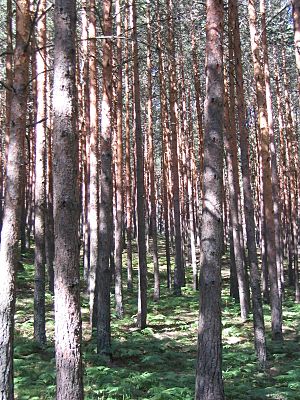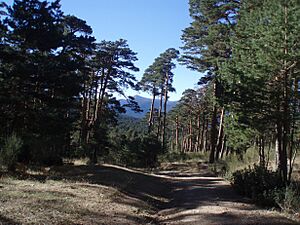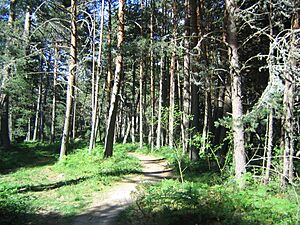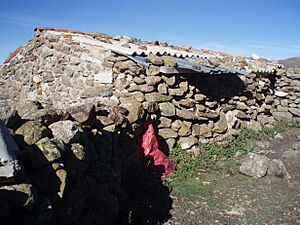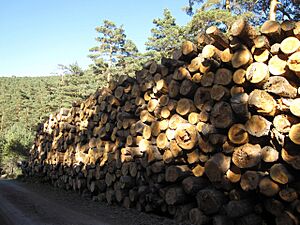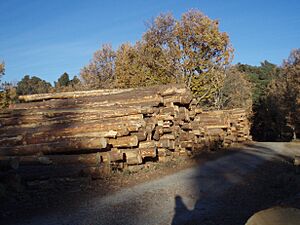Valsain Mountains facts for kids
The Valsain Mountains (in Spanish: Montes de Valsaín) are a beautiful natural area. They are found in the Valsain Valley, on the northern side of the Sierra de Guadarrama mountain range. This area is part of the town of Real Sitio de San Ildefonso in the province of Segovia, Castilla y León, Spain.
These mountains are made up of two main parts, called Pinar and Matas. Both are public lands. They are managed by the National Parks Autonomous Agency. This agency looks after the mountains through its Valsain Mountains and Sawmill Center.
There are three special areas here for people to enjoy nature. These are Boca de Asno (which has a visitor center), Los Asientos, and El Robledo. The Centro Nacional de Educación Ambiental (CENEAM), a national environmental education center, also has its buildings here.


Contents
Exploring the Valsain Mountains
The Valsain Valley sits on the northern side of the Sierra de Guadarrama. High mountain passes like Navacerrada and La Fuenfría surround it. The Sierra de Guadarrama is to the east. The La Mujer Muerta mountain range is to the west.
The valley stretches from south to north. It is about 6 kilometers wide and 9 kilometers long. The land here goes from 1100 meters up to 2125 meters high at Siete Picos. Rivers like the Eresma, Acebeda, and Peces flow through it. The soil is mostly made of granite and gneiss, which are types of rock.
The Valsain Mountains cover a large area of 10,672 hectares. Monte Pinar takes up 7,622 hectares, and Monte Matas covers 3,046 hectares. Different types of trees grow here, depending on how high up they are. The Scots pine is very common. It is even called "Valsain Pine." This tree provides excellent wood and has been used for a long time. It is important for the valley's economy.
This area is very rich in nature. There has been little human activity here. Kings of Spain historically protected it as a hunting ground. You can find many different animals, especially birds, and lots of plant types.
The CL-601 road goes through the valley and mountains. It connects Segovia with Madrid through the Navacerrada pass. Other paved roads also cross the area. Many of these roads are closed to cars. One important road goes over the Fuenfría pass. This pass has been used for travel for a very long time. It was once a Roman road, and you can still see parts of it.
How the Mountains Were Formed
Like the rest of the Sistema Central mountain range, the Valsain Mountains are made of granite and gneiss. These are strong rocks that make the soil quite acidic. Over time, these rocks cracked. This created the valleys and mountain peaks we see today.
The mountains have three main types of landscapes. These depend on how high they are, which way they face (sunny or shady), the soil, water, and winds. Human actions have also shaped these areas. The three landscape types are the mountains, the valleys, and the slopes.
Rivers and Water in Valsain
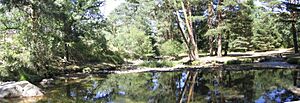
The main rivers in the Valsain Valley are the Eresma, Acebeda, and Peces. These rivers are just starting their journey here. Many small streams flow down from the mountains to form them.
It usually rains a lot in this area. Lower parts get about 885 mm of rain each year. Higher parts get around 1170 mm. Often, the rain falls as snow, especially on the mountain tops. Snow can stay there well into spring.
The Eresma river starts from streams flowing down from Siete Picos, Alto del Telégrafo, and Minguete. The Acebeda river gets its water from the slopes of Montón de Trigo and La Pinareja. The Peces river flows along the eastern edge of Monte del Pinar.
Plants of the Valsain Mountains

The most common tree here is the pinus sylvestris, also known as Scots pine. It grows in the higher parts of the mountains, above 1200 meters. Lower down, you can find Pyrenean oak. In the lowest areas, there are patches of holm oak.
Along the rivers, there are gallery forests. These are forests that grow close to water. You can also find holly, yew, poplar, sour cherry, ash, and maple trees. These mix with shrubs like broom, rock rose, juniper, and heather. There are also meadows where cattle and horses graze. This means the area has many different types of plants.
There are 867 known plant species in total. Only 69 of these are non-native. These non-native plants are found mostly in gardens and towns.
Here are some of the main plant species in the Valsain Mountains:
Scots Pine Trees
The Scots pine (Pinus sylvestris) makes up the huge pine forests that cover most of the mountains. These trees grow between 1200 and 1900 meters high. This is the highest point where forests grow here. Scots pines usually reach about 25 meters tall, but some can be over 30 meters.
In sunny areas, the trees are less dense than in shady areas. Under the pine trees, you often find oak (Quercus pyrenaica, below 1400 meters), broom, juniper, and brambles. In open spots within the pine forests, brambles are very common.
Higher up in the undergrowth, you can find juniper, broom, and wild berries. Lower down, there are plants like rowan, blackthorn, hawthorn, heather, hazel, cherry, and holly.
Pyrenean Oak Trees
The Pyrenean oak (Quercus pyrenaica) grows in the lower parts of the mountains. It is found between 1000 and 1400 meters high. These trees can be affected by early or late snowfalls. Sometimes, they grow as smaller plants under other trees.
In oak forests, the undergrowth mainly includes plants like steppe, blackthorn, privet, honeysuckle, broom, hawthorn, and rose.
Holm Oak Trees
Holm oak (Quercus ilex) grows in two smaller areas of the Valsain Mountains. One area is between 1300 and 1350 meters high on the slopes of Cabeza Grande. The other is between 1118 and 1225 meters on the northern side of Cerro Matabueyes. The plants growing under the holm oaks are mostly steppe and similar species.
Grasslands
There are different kinds of grasslands here. Many have thorny plants like wild roses, hawthorn, and blackthorn, especially if animals graze a lot. You can also find shrubs like steppe, scotch broom (Cytisus scoparius), or broom (Genista florida).
The main types of grasslands are:
- Nardus grasslands: These are found above 1300 and 1400 meters, higher than the pine forests. They are made up of Nardus stricta grass, along with other grasses and clovers. They produce a lot of grass but are not very nutritious. Wild animals and horses often graze here.
- Montane grazing lands: These are between 1100 and 1300 meters high. They grow in dry soils and are used by cattle and horses. You can also see these meadows in open areas within oak and pine forests.
- Siliceous grazing lands: These meadows are good for sheep and cattle because they are nutritious.
- Vallicar: This type of grassland forms when grazing areas are fenced in. They are found in lower, wet areas and are used for grazing livestock.
Animals of the Valsain Mountains
The Valsain Mountains are home to many animals. There are over 210 types of vertebrate animals (animals with backbones) and 570 types of insects.
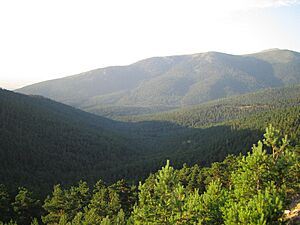
Birds
Birds are the most common group, with 150 different species. More than 100 of these birds build their nests here. Important birds include the black vulture (Aegypus monachus) and the imperial eagle (Aquila adalberti). You can also see griffon vultures (Gyps fulvus) and other birds of prey, both day and night hunters. Many forest birds live here too, like tits, woodpeckers, and different types of crows (jays, ravens, and crows).
Mammals
There are 45 types of mammals, including 15 kinds of bats. You might see wild boars, foxes, roe deers, wild cats, and otters. Some bats and other small mammals found here are unique to the Iberian Peninsula. The hedgehog (Erinaceus europaeus) and the red squirrel are also common.
Reptiles
There are 15 different reptile species. The most notable ones are the snub-nosed viper (Vipera latastei), the ringed snake (Natrix natrix), the cyren's rock lizard (Iberolacerta cyreni), and the Schreiber's green lizard (Lacerta schreiberi).
Amphibians
Ten types of amphibians live here. They are found in wet areas. Important ones include salamanders (Salamandra salamandra bejarae), newts, and different kinds of frogs and toads like the Iberian stream frog (Rana iberica).
Fish
Five species of fish live in the mountain rivers. The most common are trout, gobies, and the bermejuela.
Insects
Among the more than 570 insect species, you can find the large stag beetle (Lucanus cervus) and beautiful butterflies like Graellsia isabelae, Parnassius apollo, Leptidea sinapis, and Boloria selene castellana.
How the Mountains are Managed
The Valsain forests are managed by the Centro Montes y Aserradero de Valsaín. Their goal is to use the forest's resources while also protecting them.
They combine traditional forest and livestock farming with public use. The forests are open for people to enjoy and relax. This also helps teach people about nature.
The activities in the Valsain Mountains are very important for the area. They create jobs for over 150 people each year. They are also the main driver of forestry and wood processing.
Public Activities and Education
To help people enjoy the mountains and learn about nature, three recreation areas have been set up. These are Boca de Asno, Los Asientos, and El Robledo. All of them are next to the CL-601 road that goes through the valley. They have parking and other services.
At Boca del Asno, there is a visitor center that opened in 2004. It teaches visitors about the mountains' history, nature, and how they are managed. The center has several parts:
- Entrance: You can see a huge piece of a pine tree trunk. It shows historical events that happened during its life. Inside, there are displays of soil from the mountains.
- Reception: This is where you can get information and buy books about the area. You can also learn about different walking routes.
- Projection: A video about the mountains' history is shown. It explains how the mountains are connected to the Spanish monarchy and the local people.
- Exhibition: You can take a virtual tour through the different natural areas of the mountains. It shows a full day from sunrise to sunset.
- Thematic Exhibition: Information about the Valsain Mountains is shown on panels and computer screens. It also details the various walking paths.
- Audiovisual Room: A video shows how pine forests are managed. It tells the story of a pine tree and how it interacts with other species.
There are free guided tours to help people learn about nature and the area. These tours start from the recreation areas and other spots like Cogorros and Puerto los Cotos.
A large network of roads and paths crosses the mountains. Most are closed to unauthorized cars. These paths allow people to hike or climb the surrounding mountains, some of which are over 2000 meters high.
The Centro Nacional de Educación Ambiental (CENEAM) is also located here. It aims to inform, educate, and raise awareness about the environment. The center has various facilities, including a slideshow about life in the mountains through the seasons. There are rooms showing the special features of the Valsain Valley and the Guadarrama mountain range. An interactive walk through the pine forest around the center adds to the experience.
One popular and easy route is the Pesquerías del Eresma ("Eresma Fisheries"). This path follows the river. It starts at Boca del Asno. It was originally made so kings could travel comfortably to go fishing.

Forest Management and Sustainability
The Montes y Aserradero de Valsaín organization manages the Valsain forests. They make sure that using the forests' resources goes hand-in-hand with protecting them. They also work to improve the homes of different animals and plants. This follows a law that says forests must be managed in a way that helps nature, the economy, and people's lives.
To do this, the Valsain forests are divided into different zones. Each zone has a plan based on its features. Some areas are for logging, some for recreation, some for grazing, and some for protecting certain species. The main activity is cutting Scots pine trees.
The management of the forests is guided by several official documents. These plans ensure that the forests are used sustainably.
Sustainable Forest Management System
The management follows five main documents. These documents help understand the area and plan for the long and short term. They decide how to protect animals, plants, and the land. They also keep track of the forest's legal status, natural state, and inventory.
The plans are always being checked and updated. They compare current conditions with past records to make sure everything is going well.
The forests are divided into 25 different sections. Most of these are used for production. However, one section is not used for logging. The goal there is to let the pine forest grow naturally and become very old. In other sections, there are rules about what can be done.
The main tree harvested is the Scots pine. But other tree species are also used. For example, in the Matas mountain, Pyrenean oak is also harvested.
How Trees are Harvested
In the pine forests, trees are thinned out over time. This helps replace older trees with younger ones. When adult pines are cut, more sunlight reaches the ground. This helps new pine seeds grow. Over time, the old trees are replaced by new, young pines, completely renewing the forest.
At first, there are many young pines. Their numbers decrease naturally and with human help. People clean and cut some trees to make sure the remaining ones grow well.
In special protection areas, where endangered animals live, no cutting is done. This helps keep the forest structure stable and avoids disturbing the animals. For example, no harvesting happens within 100 meters of black vulture and imperial eagle nests. Within 500 meters, harvesting is only done at certain times.
Pines are usually cut when they are about 120 years old. They are cut with chainsaws. Then, they are moved out of the forest using horses, tractors, or loaders. After being measured, they are transported and stacked with crane trucks.
The management uses a method called Tramo Móvil. This divides the forest into sections. In each section, the number and type of trees are counted. Trees are put into three groups based on their age:
- Regeneration: Trees that are growing new. Here, thinning cuts are made.
- Improvement: When new trees have grown. Older "parent" trees left for seeds are cut.
- Preparation: Trees that are almost fully grown. Sick or dry trees are cut to prepare for new growth.
One section is always left for thinning, another for protection without cutting, and others for improvement.
In one area, 50 hectares are managed to grow a mature holly forest. This is done by thinning the pine forest's undergrowth, which is made of holly.
About 50 people work in the Valsain Mountains. They include field workers, office staff, sawmill workers, park rangers, guides, and environmental agents. The organization also works with other companies.

The Sawmill
The Valsain forests' wood is processed at El Aserradero ("The Sawmill"). This facility is located near the town of Valsain and the CENEAM. It covers an area of 12 hectares.
The Royal House built the sawmill in 1884. At first, it used steam power. The sawmill's ownership changed with the forests. In 1945, when the mountains became part of Patrimonio Nacional (National Heritage), the sawmill did too. In 1982, it came under the control of ICONA (a national nature conservation institute).
In 1952, the sawmill was made bigger and more modern. In 1985, it was updated with new machines and automation.
On October 1, 2005, a fire stopped production. The fire damaged machines and the warehouse. In 2007, sawing started again with a mobile sawmill. The reconstruction continued, adding the newest wood production technology.
The wood is sold under the brand name Maderas de Valsaín ("Valsain Woods"). It is made to meet market needs.
The sawmill has received certificates for sustainable forest management. It got the FSC certificate in 2005 and the PEFC certificate in 2004. These show that the wood is produced in a responsible way.
There are plans to build a Wood Museum at the sawmill. It would be in the old building of the Real Taller de Aserrío Mecánico (Royal Mechanical Sawmill Workshop).
History of the Valsain Mountains

Historically, the Valsain Mountains belonged to the city of Segovia. Local groups managed them. In 1579, hunting and fishing were banned here. This made it one of the first protected natural areas.
In 1761, King Carlos III bought the mountains because they were good for hunting. He wanted them as a royal hunting reserve. Between 1869 and 1876, the mountains were privately owned for a short time. But they mostly returned to the Crown.
When the Second Spanish Republic began, the mountains became state property instead of belonging to the Crown.
In 1940, they became part of Patrimonio Nacional. In 1982, they were transferred to ICONA. When ICONA closed in 1985, the mountains became part of the National Parks Autonomous Agency (OAPN), which still manages them today.
The first attempt to protect the environment here was in 1920. There was a plan to make the entire Sierra de Guadarrama and Valsain Mountains a national park, but it failed. Later, in 1930, three small areas were protected as "Natural Sites of National Interest." One of these was the Pinar de La Acebeda.
In 1988, the Valsain Mountains were declared a Special Protection Area (SPA). This was because of the many important and unique birds, with over 100 nesting species. In 1995, it was included in the Natura 2000 Network of protected areas by the European Union.
Since 2003, it has been part of the Protected Natural Areas Plan of Castilla y León.
Environmental Protection
The Valsain Mountains have several important protections:
- It is a Special Protection Area (SPA) for birds.
- The Sitio Natural de Interés Nacional del Pinar de la Acebeda ("Natural Site of National Interest of the Acebeda Pine Forest") covers 587 hectares of the Valsain Pine Forest. This was declared in 1930.
- It is a Critical Area for the recovery plan of the Iberian Imperial Eagle in Castilla y León.
See also
 In Spanish: Montes de Valsaín para niños
In Spanish: Montes de Valsaín para niños
- Sistema Central
- Valsain Valley
- La Mujer Muerta
- Sierra de Guadarrama



